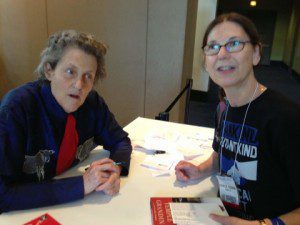Working While Autistic: An Introduction
Before the PEN America panel on Crossing Borders, I got together with a friend whom I’d invited to join me at the event. She and her husband were leaving for Portugal in a couple of weeks, and she wanted advice on places to visit. The conversation drifted to other topics, among them my blogging as a way of getting my ideas out in a tough publishing environment.
A lot of authors I know, both traditionally and self-published, write for high-volume online publications such as Huffington Post and Book Riot. Various people have suggested that I do the same, but the truth is, I don’t know where to begin. I don’t have connections with anyone who writes for any of these outlets, and anyway, all my life, I’ve been content with the idea of going it alone. When I was in school and assigned to group projects, I’d first ask the teacher if I could do an individual project instead. When the teacher declined, I usually ended up in a group in which I did all the work in exchange for the other group members leaving me alone. The good thing about the arrangement is that for once, my classmates didn’t bully me because they were dependent on me, and I could believe for the duration of the project that they were my friends. The other good thing is that I had complete control and didn’t have to worry about their mistakes — only my own.
My difficulties working with others in a school setting was nothing, however, in comparison with the challenges of being on the autism spectrum in the workplace. Sometimes I succeeded in my jobs. A few years out of college I taught high school history, English, and speech at Brooklyn Technical High School in New York City, a specialized school for academically gifted students. My knowledge and passion for the subject matter inspired my students, and teaching multiple disciplines (due to my extensive academic preparation) allowed me to combine the techniques of each discipline in creative ways. I became a popular and respected teacher, and had my husband not taken an academic position in Madison, Wisconsin two years into my New York City teaching career, I may still be teaching at Brooklyn Tech today.
Ten years later, after receiving my Masters in Library and Information Science at the University of Wisconsin, I became editor of MultiCultural Review, a job I had for 16 years until the journal folded in the Great Recession. This job allowed me to work remotely, and I worked well with my far-flung team. I came to depend on members of my team to compensate for my weaknesses, specifically the marketing people who showed up at conferences and expanded the subscription list while I labored behind the scenes.
My friend and I talked about the difficult transition from school to workplace for young people on the autism spectrum, a growing concern with the large numbers of autistic youngsters graduating from high schools and universities. In her article titled “Transition From School to Work” for the Autism Research Institute, Temple Grandin writes, “For many able people with autism college years were their happiest.” (That was certainly the case for me.)
My friend suggested that I use my blog to explore ways that workplaces can more effectively use the talents of autistic people, and what kinds of behaviors co-workers and supervisors should avoid. I can talk about some of the mistakes that I’ve made in the past, and what might have triggered those problems, as well as ways that problems could have been avoided in the first place. If you, dear reader, have questions or observations that you’d like me to write about in more depth, please let me know, and I can devote a blog post to the subject.
Update: Check out the additional posts in this series, about group projects, internships, volunteer work, and turning a miscommunication into a positive new direction.








Lyn, I’m so glad you’re going to write about how workplaces can better use the talents of autistic people. I’m really looking forward to reading your insights about how the kinds of issues you have experienced were triggered and could have been avoided. I know this is not quite on topic, but at some point if you ever have the time or interest, I would also love to read a post from you exploring the question of how teachers can more effectively honor and nurture the talents of autistic students…or I’d just love to talk to you about that someday. 🙂
Thank you, Laurie, and congratulations on your forthcoming books! I’d love to talk with you about it, and turn some of those ideas into a blog post that can benefit other teachers. I’ll email you!
Thank you for this, Lyn. Everyone needs to know what you have to tell us.
Thank you for reading! I have some topics already in mind, including one on internships and volunteer work. Hint: They’re not a panacea.
I work with many individuals in the spectrum and I place them in internships that become jobs after 6 months. The success of an internship placement is the result of a good match between the student’s skills, motivations and desires and a carefully chosen business environment. Plus, continuous coaching, of course. I’d love to talk to you if you’re interested
I would like to talk with you as well. I’ve had several internships that didn’t turn out well, and the problem had to do with a poor choice of business environment along with a lack of supervision.
Lyn, you have such great experience. And what a great idea to use your blog to help others (as you’ve done so many times). Thank you for your transparency!